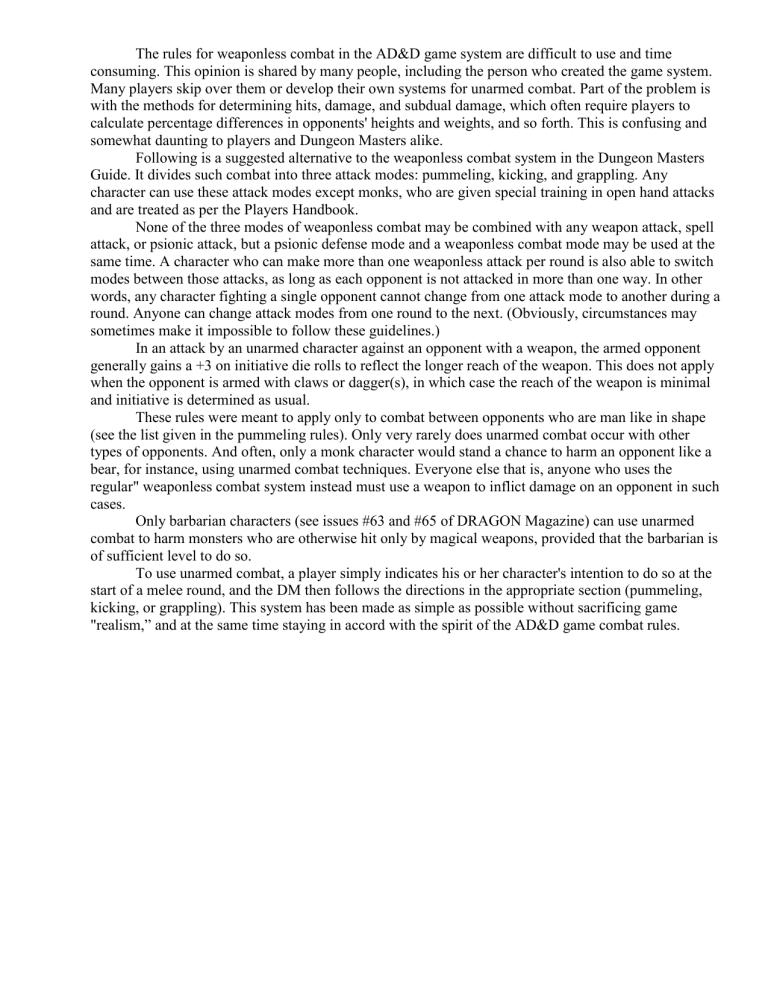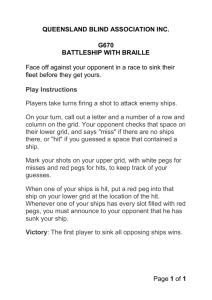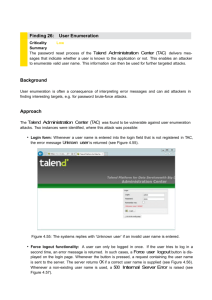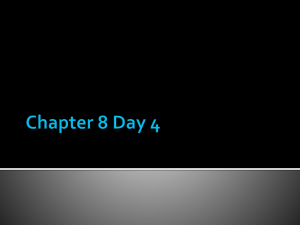Unarmed combat

The rules for weaponless combat in the AD&D game system are difficult to use and time consuming. This opinion is shared by many people, including the person who created the game system.
Many players skip over them or develop their own systems for unarmed combat. Part of the problem is with the methods for determining hits, damage, and subdual damage, which often require players to calculate percentage differences in opponents' heights and weights, and so forth. This is confusing and somewhat daunting to players and Dungeon Masters alike.
Following is a suggested alternative to the weaponless combat system in the Dungeon Masters
Guide. It divides such combat into three attack modes: pummeling, kicking, and grappling. Any character can use these attack modes except monks, who are given special training in open hand attacks and are treated as per the Players Handbook.
None of the three modes of weaponless combat may be combined with any weapon attack, spell attack, or psionic attack, but a psionic defense mode and a weaponless combat mode may be used at the same time. A character who can make more than one weaponless attack per round is also able to switch modes between those attacks, as long as each opponent is not attacked in more than one way. In other words, any character fighting a single opponent cannot change from one attack mode to another during a round. Anyone can change attack modes from one round to the next. (Obviously, circumstances may sometimes make it impossible to follow these guidelines.)
In an attack by an unarmed character against an opponent with a weapon, the armed opponent generally gains a +3 on initiative die rolls to reflect the longer reach of the weapon. This does not apply when the opponent is armed with claws or dagger(s), in which case the reach of the weapon is minimal and initiative is determined as usual.
These rules were meant to apply only to combat between opponents who are man like in shape
(see the list given in the pummeling rules). Only very rarely does unarmed combat occur with other types of opponents. And often, only a monk character would stand a chance to harm an opponent like a bear, for instance, using unarmed combat techniques. Everyone else that is, anyone who uses the regular" weaponless combat system instead must use a weapon to inflict damage on an opponent in such cases.
Only barbarian characters (see issues #63 and #65 of DRAGON Magazine) can use unarmed combat to harm monsters who are otherwise hit only by magical weapons, provided that the barbarian is of sufficient level to do so.
To use unarmed combat, a player simply indicates his or her character's intention to do so at the start of a melee round, and the DM then follows the directions in the appropriate section (pummeling, kicking, or grappling). This system has been made as simple as possible without sacrificing game
"realism,” and at the same time staying in accord with the spirit of the AD&D game combat rules.
PUMMELING
1.
Two pummeling attacks may be made per round by members of non-lighter classes, humanoid monsters (those listed below), and by lower level members of the fighter class (fighters and paladins of levels 1-6, rangers of levels 1-7, and barbarians and cavaliers of levels 1-5).
Three pummeling attacks may be made per round by fighters and paladins of levels 7-12, rangers of levels 8-14, and barbarians and cavaliers of levels 6-10.
Four attacks per round may be made by fighters and paladins of level 13 or higher, rangers of level 15 or higher, and barbarians and cavaliers of level 11 or higher.
Any attacker must have at least one hand free to pummel.
2.
The attacker makes a normal roll to hit against the opponent, applying strength to hit for a fist or open hand against the bonuses as well as armor class adjustments armor type the opponent is wearing
(for these, see this article's appendix). The opponent gets armor class adjustments for high or low dexterity as usual.
Add a further +1 to hit if the attacker is using a dagger pommel to strike with, or +2 to hit for an attacker using metal gauntlets or cesti. (These two bonuses are not cumulative.) The attacker may also be eligible for these bonuses to hit: +2 vs. an encumbered opponent, or on an attack from behind (but thieves and assassins, of course, strike from behind at +4); or, +4 against opponents who are prone, slowed, partially bound, or stunned. Any pummeling attack automatically hits an opponent who is immobile (e.g., asleep, held, or paralyzed).
If the attacker is charging, the first pummeling attack is made at +2 to hit, but no other unarmed attack during the melee receives the same bonus. Also, note the penalties to armor class for a charging attacker, as outlined in the Dungeon Masters Guide, p. 66.
3.
If a hit is scored, determine damage according to this table:
Attacker "To hit" Pummel Chance strength modifier damage to stun
------------------------------------------------------------------
3 -3 1 0%
4-5
6-7
8-9
10-11
12-13
14-15
-2
-1
+0
+0
+0
+0
16
17
+0
+1
18 +1
18/01-50 +1
18/51-75 +2
18/76-90 +2
18/91-99 +2
18/00
19
20
+3
+3
+3
21
22
23
24
+4
+4
+5
+6
1
1-2
1-2
1-2
1-2
1-2
1-3
1-3
1-4
2-5
2-5
3-6
4-7
5-8
6-9
7-10
8-11
9-12
10-13
11-14
0%
0%
01%
02%
04%
07%
10%
13%
16%
20%
25%
30%
35%
40%
50%
60%
70%
80%
90%
100%
------------------------------------------------------------------
Bonuses to damage: +1 for pummeling with a dagger pommel, or +2 for pummeling while wearing metal gauntlets or cesti.
Note: Strengths higher than 18/00 are given for characters using magical potions or effects to increase their strength to giant levels (see girdle of giant strength, DMG p. 145).
The chance of stunning an opponent with a given blow is equal to one's chance to bend bars / lift gates. A stunned combatant is disoriented for the remainder of the current round and all of the following round, during which time his attacks are made at -1 to hit, and he loses the benefit of any dexterity bonuses to armor class. In addition, any character attacking a stunned opponent does so with a +4 bonus to hit unless the attacker is also stunned, in which case the -1 penalty to hit applies instead.
The effect of consecutive or close together stunning blows is not cumulative; a combatant cannot be stunned when he is already in that condition. However, it is possible for an attacker to (in effect) keep an opponent continually stunned by winning the initiative in every odd-numbered round and landing a stunning blow on the first pummeling attack that follows in that round. Monks are immune to this stunning effect, as are all tighter class characters (including paladins, rangers, etc.) who are high enough in level to get three or more pummeling attacks per round.
Pummeling damage is considered "real" damage, and may be healed the same as any other sort of damage (by the use of spells or potions, by resting, etc.). When a victim takes enough damage from a particular pummeling attack to bring that character to zero hit points, the victim falls unconscious for
1-4 turns. He is left with zero hit points during this time; points of damage that would have brought his hit point total to less than zero are simply dropped. This allows captives to be taken, and reflects the
generally non-lethal nature and intent of weaponless combat. However, damage taken from a monk's open hand attack is treated like any other attack damage, and can kill opponents.
4.
If an attacker is using the pommel of a magical dagger, the "to hit" and damage bonuses of the dagger may be applied to pummeling attacks as well.
5.
Hard armor (AC 5 or better) is bad news for bare handed attacks. A character who attempts to pummel someone wearing hard armor will take 1 point of damage himself on every strike. Using a dagger pommel or a rock, or wearing metal gauntlets or cesti, will prevent this damage.
6.
All of the player character races humans, dwarves, elves, half-elves, half-orcs, gnomes, and halflings, may make pummeling attacks. Monsters of man like shape and size (up to the height of an ogre) may also make pummeling attacks. Note that some monsters, like quaggoth and trolls, do not pummel because they have effective claw attacks instead.
If the strength of a pummeling combatant is not known, use the following list as a guideline to the average strength for a member of the character or creature's race:
8 - halfling*
9 - kobold, skulk, tasloi, xvart
10 - gnome*, goblin, human*
11 - frost man, gibberling, half-elf*, spriggan (small), svirfneblin
12 - derro, duergar, elf*, half-orc*, half-elf*, orc
14 - dwarf*, norker
15 - grimlock, hobgoblin, qullan
16 - gnoll, half-ogre*
17 - bugbear, flind
18 - cyclopskin, ogre (no percentile roll)
18/01 - Ogrillon * - average NPC value
Leader types and chieftains of these races will be somewhat stronger than average, as a rule, and females will generally be somewhat weaker. Ogrillons are exceptional in two ways: their tough fists and high strength enable them to deal 2-7 points of damage on a pummeling attack (the only way an ogrillon fights), and, unlike "normal" pummeling attacks, damage from ogrillon blows can kill.
KICKING
1.
Members of the fighter class (or one of its subclasses) may attack by kicking twice per round. All other characters and creatures can attack by kicking once per round. To make even a single kicking attack, both feet must be unchained or otherwise unencumbered and free to move.
2.
A kicking attempt is resolved by making a normal "to hit" roll (including strength bonus or penalty, if any), but incorporating the adjustments for armor class as if the attacker was using a club.
Barefoot kicking is done at -1 "to hit," but the attacker takes no damage from kicking hard armor, unlike pummeling. Bonuses apply to the chance to hit against opponents hampered in some way, as per the pummeling rules. The attacker gets +2 "to hit" when making a charge, but only one kick can be made in the first melee round immediately following the charge.
3.
If a hit is scored, use the pummeling table to determine a base figure for damage according to strength. A kick attack gets a +2 bonus to damage if the attacker is wearing hard or metallic boots, or +1 to damage if the attacker is wearing soft boots or is barefoot. Also, a kick made at the end of a charging run is +2 to damage over and above these standard bonuses.
The chance to stun an opponent by kicking is the same as for a pummeling attack, dependent on strength. Damage taken from kicking is treated the same as any other damage; unlike pummeling damage, kicking damage can kill by reducing the victim's hit points to below zero.
A kick results in a knockdown any time the maximum possible damage is rolled on at attack. If this occurs against an opponent that is no more than 1½ times the height of the attacker, the opponent must save vs. paralyzation or be knocked down. The victim of a knockdown loses any further attacks in the current melee round and automatically loses initiative in the following round.
4.
Monsters will use kicking attacks only in the rarest circumstances, such as when the monster is cornered and has no other way to attack. But even in those cases, the monster will generally attempt to pummel before trying to kick.
GRAPPLING
1.
No character or monster can make more than one grappling attack per round. The attacker must have both hands free and cannot be holding something in one or both of them.
2.
A character or monster attempts a grappling attack by making a normal "to hit" roll and incorporating adjustments for hampered opponents and for charging, as given in the pummeling rules.
No armor class adjustments are used, unlike pummeling and kicking. However, each type of grappling attack carries a penalty "to hit" according to its difficulty and complexity. Likewise, damage varies from one attack form to another. The following list gives each attack form, its "to hit" penalty in parentheses, and notes on damage and other details.
A: Pin one arm and hold (-2) causes 1 point of damage when the pin is applied and another 1 point for each round the hold is maintained. The opponent can break the pin immediately
(but not negate the initial 1 point of damage) by making a successful roll to open doors in the same round. If the pin is not broken, it can be maintained from round to round if the attacker continues making the required roll "to hit" and if the opponent continues to fail his roll to break the hold. An opponent pinned in this way can still make a pummeling attack with his free hand, or kick, or strike (at -2 "to hit") with a weapon being held in the unpinned hand. This attack form can be turned into a pin of both arms (attack form B) if the attacker makes a second roll "to hit" for attack form A in a subsequent round; however, the hold is broken entirely if the second attack fails.
B: Pin both arms and hold (-4) causes 1-2 points of damage initially and another 1-2 points for each round in which the hold is maintained. As above for attack form A, the opponent must make an "open doors" roll to free one arm from the pin. He is entitled to two separate rolls in the same round to try to break the hold entirely; if the opponent succeeds in freeing only one arm, the attack is then treated as a one arm pin (attack form A), for as long as the one arm hold is maintained. An opponent with both arms pinned may try to kick, throw (attack form F), or knock flat (attack form D) his attacker, but cannot effectively use any other attack method. The attacker may turn this hold into a bear hug
(attack form C) in a subsequent round by simply doing so; no roll "to hit" is required in this case.
C: Bear hug / crush (-2) does 1-4 points of damage, plus the attacker's strength bonus or penalty, for each round the hold is maintained. Since this hold is applied only to the torso, the opponent has his arms and hands free; he may strike back with a weapon (at -2
"to hit") or by pummeling or kicking, or by trying to throw his attacker or knock him flat.
If either of the latter two attacks succeeds, the attacker's hold is broken. Otherwise, the hold may be maintained until the defender does 3 points of damage or more in a single counterattack, or until the attacker loses half of the hit points he had when the hold was begun.
D: Knock flat and hold down / overbear (-4) does 1-6 points of damage, plus strength bonus or penalty, per round. The opponent can try to "shake off' the attacker and get back to his feet, at a chance equal to twice the character's percentage roll for bending bars / lifting gates. Or, the opponent can try to pummel or kick, or may attack with a weapon (if possible) at -4 "to hit." The attacker can maintain his superior position, and keep dealing damage to the opponent, as long as desired or until the opponent causes 3 points of damage or more in a single counterattack, or until the attacker is reduced to half of the hit points he had when the overbearing attack was made.
E: Choke hold (-4) does 1-6 points of damage, plus strength bonus or penalty, per round.
The opponent makes all strikes against the attacker at -2 "to hit," including unarmed attacks except for an attempt to throw the attacker (attack form F), which is still done at the normal chance, using only the standard -6 penalty "to hit."
F: Throw / flip (-6) does 1-10 points of damage, plus strength bonus or penalty, only in the round the throw is accomplished (also see Rule 3 below). In addition, the opponent is automatically stunned (as per the pummeling rules) and automatically loses his next initiative roll.
G: Trip (-2) does 1-2 points of damage in the round it is accomplished, if the opponent fails to roll his dexterity score or less on 3d6. The opponent is able to get back to his feet, if desired, for the start of the next round, but any item or weapon being held may have been dropped (50% chance) in the fall; if so, the opponent automatically loses initiative for the next round if he wants to retrieve the object immediately.
An unarmed attacker may use only one grappling attack form per round, but may switch attack modes from round to round. All damage suffered from grappling attacks is treated the same as damage from pummeling attacks; opponents taken to zero hit points or less will fall unconscious with zero hit points and will remain in that condition (unless slain) for 1-4 turns, after which time they will regain consciousness with 1 hit point. The remainder of damage is recovered by normal means (rest or magic).
3.
An attacker receives +2 "to hit" when attempting to grapple an opponent less than ½ of the attacker's height, and a +2 to damage on any hit with attack form F (Throw / flip).
An attacker suffers a -2 penalty "to hit" when attempting to grapple an opponent who is more than 1½ times the attacker's height, and against such opponents attack form F (Throw/flip) cannot be` used.
Appendix: Armor class adjustments” to hit" for pummeling and kicking
Fist or
2 3 4 5 6 open hand -7 -5 -3 -1 0
Armor class
7
-------------------------------------------------------------------------------
0
8
+2
9
0
10
+4
Bare foot
(as club) -5 -4 -3 -2 -1 -1 0 0 +1
-------------------------------------------------------------------------------
A) Armor classes better than 2 are treated as AC 2.
B) Opponents having AC 8 or AC 10 are assumed to not be using shields;
C) opponents with AC 9 are assumed to have shields.






